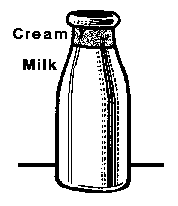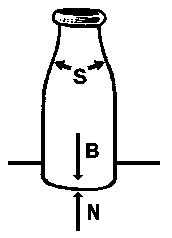Pressure Paradox.
This is not yet ready for publication.
 |
An old-fashioned bottle of nonhomogenized milk is left undisturbed. The cream in the milk rises to occupy the narrow neck at the narrower top of the bottle. Is the pressure of the milk on the bottom of the bottle now the same, greater, or less than before?
You know this puzzle is old, for those milk bottles are seldom seen today. Nor is unhomogenized milk common. However, many food products come in similar narrow-necked bottles. For a modern version imagine such a bottle of oil-and-vinegar salad dressing, shaken up. Then the oil slowly separates and rises to the narrow neck of the bottle. Note: Many materials, when mixed, occupy a volume different from their total volume when separate. This is generally a small effect. In this problem, this volume difference will be ignored. It would have negligible contribution to the changes of pressure being considered here.
Answer.
The total force that the bottom of the bottle exerts on the table stays the same. After all, the total weight of bottle and its contents hasn't changed. However, the pressure (force/area) of the liquid acting on the bottom of the bottle does decrease. It pays to read problems carefully.Condsider a vertical column of liquid at the centerline of the bottle, of diameter equal to that of the narrow bottle neck. It originally contained a mixture of milk and cream. Cream is less dense than milk. After separation the cream is on the top, so the central column now has a higher cream/milk ratio. This decreaes the pressure at the bottom of the column. But by Pascal's law, the pressures in a liquid depend only on height, so the pressure is decreased all across the bottom of the bottle. This tells us that the net force on the bottom of the bottle has decreased.
 |
Do the forces on the bottle add to zero? Yes, because the liquid that rose in the neck of the bottle exerts forces on the bottle's neck. The shape of the bottle neck ensures that those forces have upward vertical components, and these sum to a smaller value, equal to the decrease of force on the bottom of the bottle.
If the bottle were a perfect cylinder this would not be an interesting problem.
But suppose the bottle had a shape consisting of two cylinders, a smaller diameter one above a larger one. And suppose that the bottle design was such that after separation, the cream exactly fills the upper cylinder and the milk the lower one. This seems to demolish our comment about the forces acting on the tapered neck of the bottle, for they now have no vertical components. Get us out of this apparent dilemma.
Further reading.
Arnold B. Arons' A Guide to Introductory Physics Teaching (Wiley, 1990) has a good discussion in Section 11.3 Hydrostatic Pressure.
Feedback is appreciated from readers. Email dsimanek@lhup.edu. If you have a favorite physics puzzle that is not well known, not easily found on the web, or in the many published physics problem books, send it along. Include your answer, if you have one. If your idea is used, we'll credit you. I especially like puzzles that can be solved with insightful and simple arguments, preferably with minimal mathematics.
Return to Physics puzzles.
Return to the Donald Simanek's home page.